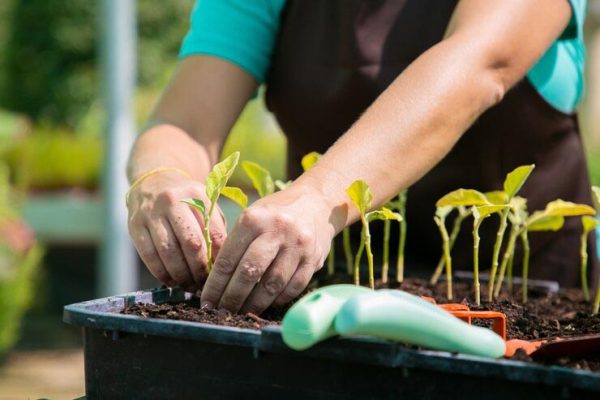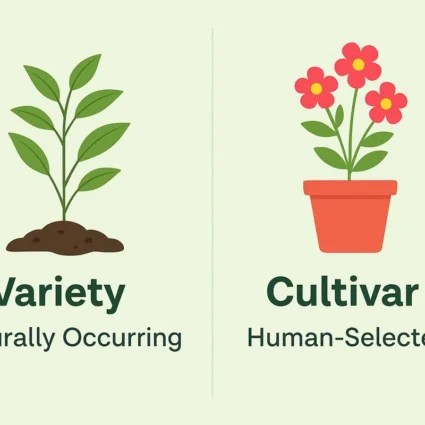
Transplanting Seedlings: Knowing When and How to Move from Seed Tray to Garden or Containers
Gardeners who prefer to witness plant growth from seeds often sow them in seed trays. This allows them to plant multiple seeds simultaneously, and the seed tray makes it easier to control moisture and temperature. Consequently, seeds germinate quickly. However, once the seeds have sprouted, they require more growth space. If left in the seed tray for too long, it can adversely affect their growth, as they may need more nutrients. Nevertheless, many individuals need to learn when to transplant seedlings from the seed tray.
What Is Transplanting

Transplanting is moving tiny seedlings from one location to another, giving them enough space to grow and develop. Typically, most seeds are germinated in a controlled environment, resulting in seedlings. Once the seedlings reach 6 to 8 inches after germination, they are transplanted into an external environment, such as garden beds or containers, to foster optimal growth. During the transplanting process, adequate spacing is ensured for the root expansion of the plants, and the distance between the seedlings is determined for better development.
Also Read This :Effortless Elegance: Low-Maintenance Succulents Perfect for Indoor Gardens
When to transplant seedlings from seed tray, know here

Transplanting seedlings from a seed tray to larger containers or directly into the garden should be done at the right time to ensure the best chances of success for the plants. Here are some general guidelines on when to transplant seedlings:
True Leaf Stage:
Please wait until the seedlings have developed their first set of true leaves. The first leaves that appear are usually seed leaves (cotyledons), and the next set is the actual leaves, which resemble the mature plant’s leaves.
Size and Vigor:
Transplant seedlings when they have reached a suitable size and show strong, healthy growth. Larger, robust seedlings are better able to withstand the stress of transplantation.
Also Read This :Know how to grow succulent plants in your home garden? Here are the tips
Root Development:
Check the roots of the seedlings. If they are becoming root-bound or starting to circle the edges of the seed tray cells, it’s time to transplant. Healthy root systems are crucial for successful transplanting.
Weather Conditions:
Choose a day with mild weather conditions for transplanting. Avoid transplanting during hot, windy, or excessively sunny days, as these conditions can stress the seedlings.
Time Since Germination:
Consider the recommended time frame for transplanting specific types of seedlings. Some plants have specific needs regarding the duration they should spend in the seed tray before transplanting.
Also Read This :Hibiscus Happiness: A Guide to Caring for Your Plant
Hardening Off:
If you’ve been starting your seedlings indoors, hardening them off before transplanting is essential. Gradually expose them to outdoor conditions for increasing amounts of time over several days to acclimate them to the new environment.
Soil Moisture:
Water the seedlings a few hours before transplanting to ensure the soil is moist. Moist soil helps the seedlings to come out of their containers more efficiently, minimizing root disturbance.
Also Read This :Meet the Green Guardians – Houseplants live for Over a Century
Transplanting Time of Day:
Transplant in the late afternoon or cloudy day to reduce plant stress. This allows them some time to recover before facing the full intensity of the sun.
Spacing Considerations:
Be mindful of the recommended spacing for the particular plant species. Transplant seedlings at the appropriate distance from each other to ensure proper growth and airflow.
Also Read This :From Feng Shui to Oxygen Boost: The Multi-Faceted Benefits of Snake Plants
Garden/Container Readiness:
Ensure your garden bed or containers are prepared and ready for the seedlings. Have the soil amended and any protective measures in place, such as mulch or plant cover.
Remember to gently handle seedlings and transplant them carefully to avoid damaging the delicate roots. Following these guidelines will help ensure a smooth transition for your seedlings from the seed tray to their new growing environment.

Also Read This :Easy and Budget-Friendly Herb Propagation from Cuttings
FAQs: Transplanting Seedlings from Seed Tray to Garden or Containers
Q1: When is the right time to transplant seedlings from a seed tray?
A: Transplant seedlings when they have developed their first set of true leaves and are sturdy enough for the move.
Q2: How do I know if my seedlings are ready for transplanting?
A: Look for signs such as the appearance of true leaves, vigorous growth, and healthy root development. Ensure they are not becoming root-bound in the seed tray.
Q3: Can I transplant seedlings directly into the garden or use containers?
A: It depends on the plant type and your gardening preferences. Some plants do well when directly planted in the garden, while others thrive in containers.
Q4: What precautions should I take when transplanting seedlings?
A: Choose a mild weather day, water the seedlings beforehand, and handle them gently to minimize stress. Consider hardening off if they’ve been indoors.
Q5: How much spacing should I provide between transplanted seedlings?
A: Follow the recommended spacing for the specific plant species to ensure proper growth and airflow.
Q6: What should I do if my seedlings show stress after transplanting?
A: Ensure they receive adequate water and protection from extreme weather conditions. Consider providing shade if necessary.
Q7: Can I transplant seedlings at any time of the day?
A: It’s preferable to transplant in the late afternoon or on a cloudy day to reduce plant stress before exposure to full sun.
Q8: Do I need to amend the soil when transplanting into the garden?
A: It’s advisable to prepare the soil with organic matter and ensure good drainage. Follow the specific requirements of the plants you are transplanting.
Q9: Should I fertilize my seedlings after transplanting?
A: Fertilize with a balanced, water-soluble fertilizer according to the recommended rates. Avoid over-fertilizing, as it can harm the seedlings.
Q10: How do I prevent transplant shock in seedlings?
A: Minimize root disturbance, water adequately, and provide a suitable environment for recovery. Avoid unnecessary handling during the process.
Also Read This :Growing 10 Ornamental Leafy Plants Successfully in Indoor Pots




